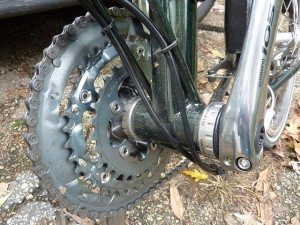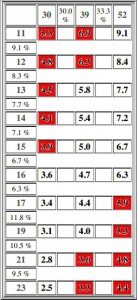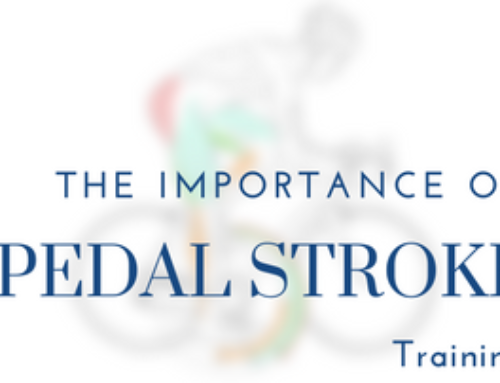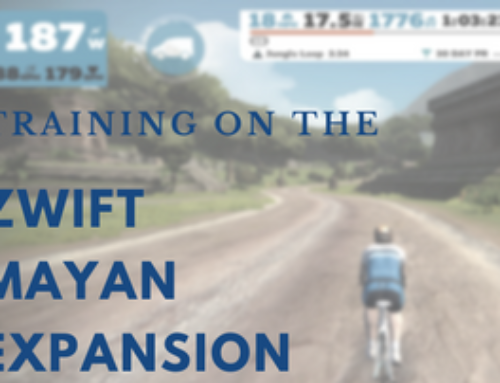 [dc]S[/dc]ince my previous post apparently stirred up a bit of controversy, I think it's appropriate to address the following question:
[dc]S[/dc]ince my previous post apparently stirred up a bit of controversy, I think it's appropriate to address the following question:
"Why didn't you include triple cranksets in your comparisons?"
Well, the simple explanation is because triples are irrelevant.
"What?"
Yes, they're irrelevant. With the rise of compact gearing and wide range cassettes, triple cranksets have been relegated to the dustbin of cycling history (with the notable exceptions of loaded touring and possible commuters.) But the question remains, why is this the case? Let's find out.
Proprietary Parts
One of the biggest complaints about a triple drivetrain is the use of proprietary parts. This includes a triple specific left shifter, front derailleur (modified cage to push the chain off the small ring onto the middle) and rear derailleur (long cage to take up additional chain slack when in the small ring.) This doesn't include the obvious triple crankset and chainrings, and in some cases a specific bottom bracket with longer spindle (in the case of cartridge BBs.) You'll also be needing to either get a new chain or add links to your old chain, which further adds to the cost of a triple. To compound the cost issue of these proprietary parts is the fact that almost no manufacturer specs a triple option on any bike over $1500, so there's little way to take advantage of a company's purchasing power. Why? Because double shifters, derailleurs and cranksets are highly compatible, if not universally compatible. This makes if extremely easy for manufacturers to spec bikes and doesn't require an entire separate stock of parts just to fulfill a very small portion of the market share.
The last hit to the marketability of the triple setup is the fact that there are no high end triple offerings on the market from major manufacturers. SRAM doesn't do triple at all, Shimano only has a triple in the Ultegra and lower lineup and triples are all but gone from Campy's product line. Finding a high end example of a triple requires going to an outside manufacturer or several generations back from the major guys. What does that say about their confidence in what the market will bear?
But enough about the marketing and technology side of things, let's get down to usability, or lack thereof.
Why Do People Choose Triples?
Lots of answers appear here, from the proverbial "I can't climb those hills so I need a lower gear" to the "I like tighter ratios because I can spin closer to my preferred cadence" arguments. Is there any truth to those assertions or is it all bunk?
Take a look at the chart to the right, and you'll see a typical triple setup (standard triple of 30-39-52 and a close ratio 11-23t 10 speed cassette.) The chart is courtesy of Sheldon Brown's Gear Calculator, and is set up for 700/23mm wheels with 172.5mm crank arms and the results are displayed as gain ratios.
You'll note the highlighted gears are gear combinations that A) are unadvisable to use due to chain rub/crosschaining and B) are replicated elsewhere on the drivetrain with a better chain line and no front derailleur rub. Essentially, you have 17 useable gears out of a possible 30. So, there are 13 gears that you'll likely never use (or shouldn't be using anyway.) Why have those 13 gears if you're not going to use them?
20 Gears?
Let's take a look at a similar chart set up for a compact crankset (34/50t) and a wide range 12-27t 10 speed cassette (all the other paramaters from the previous example are the same; 700/23mm wheel, 172.5mm crank arms and the results are displayed in gain ratios.)
You'll find something very interesting: namely that you have a lot fewer overlapping gears and a lot fewer crosschained gears. You have 15 (maybe 16 if you use the 34/14 combination on occasion) useable gears that don't result in cross chaining or derailleur rub. Compare this with the 17 useable gears available on the triple set up, and it's plainly obvious that the double requires less front shifting AND less rear shifting to find the right gear ratio. Frankly, it's far easier to shift the rear derailleur to get the necessary ratio than it is to shift the front (or both as is often warranted on a triple set up.)
Lower gears and close ratios?
You'll note that the absolute lowest gear ratio of the compact setup is actually lower than the triple in this case. You'll see the highest gear is slightly lower than the triple setup (which could be rectified with am 11-27t cassette.) Mainly, this illustrates the fact that you can achieve almost the same gearing with a compact as you can with a triple, although you will give up a small amount of the close spacing you'll get with the triple.
In reality, if you compare the jumps in an 11-23 cassette and a 12-27 cassette, you're only talking maybe 3 RPM difference between them. What that means is if you ride the triple/11-23 @ 90 RPM and shift to one harder cog, you'll pedal @ 88 RPM for the same speed. On the compact, you'll probably pedal about 85 RPM for the same speed, making the difference essentially negligible.
Sure, you can always put a 12-27 on the triple drivetrain and end up with a very, very low gear (some have even gone so far as 30, 32 and 34t big cogs to give less than 1:1 ratios) but then you still have the problem of having large spaces in the cassette and 13 redundant gears. This may or may not be a solution for some, but is it worth the cost of admission for a couple points of decrease in gain ratio?
Physiological and Biomechanical Considerations
Frankly, from a physiological standpoint, you're better off pushing those larger gears uphill: sure it's going to be hard and you might even need to get off to rest, but you'll get better and stronger much faster than if you use the crutch of the triple. Think of it like lifting 5 pound weights every day: eventually you'll be able to lift 5 pounds easily, but you won't get any stronger if you don't add more weight. By challenging the body, you get stronger and actually "grow into" your compact gearing.
Another problem often cited is the biomechanical issue of a wider stance presented by triple cranks. This wider stance affects the q-angle which is the angle between the femur and the tibia (thigh and shin bones.) The decreased q-angle from the wider pedal stance causes issues with many people (notably women who have increased q-angles to begin with) and can lead to knee or hip issues.
Ultimately: Why A Triple?
The only valid answer for this is personal preference, or if you're engaged in loaded touring (in which case a triple is definitely helpful for dragging 70 pounds of gear + yourself up all kinds of terrain.) For any mid level recreational cyclist, the gearing available on a compact crankset is more than enough to get you over 99% of all the terrain here in the northeast. Saying you're not strong enough isn't going to cut it: you can always get stronger, and the triple won't help you do that.
As an added "food for thought" bouns, consider that even mountain bikes, which very often see stupidly steeper gradients than their road going cousins, have shunned the triple. That's right…most mountain bikes nowadays are running 24t or 26t small rings and 36t or 38t large rings. Triples have even been deserted on the trail…








I recently saw a Dura-Ace triple crankset on a high end road bike. So apparantly, triples are available thruout the Shimano lineup. Even if Shimano no longer makes Dura-Ace triples, Ultegra is an excellent high end choice.
Citing the high cost of converting a double to a triple, while true, is not an issue, since most people will simply buy a bike with the triple already on it, so that feature would be free.
The last triple offered by Dura Ace 7800, the last by Ultegra was the 6700 series. There’s currently no triple in the Shimano line above Tiagra. Not even 105.
There’s absolutely no need for a triple on a bike today with wide range cassettes and compact doubles. Unless you’re loaded touring, a compact double is lighter, easier to shift, less redundant gear overlap and easier to tune/service.
YMMV.
You definitely have your mind made up about triples. I started cycling when I turned 53 because my knees were shot from 35 years of punishment to my racquetball legs could no longer compete with most of my A level friends, even with double knee braces. I was always one of the quickest as my legs were natural for starting/stopping and changing direction, but not natural cycling legs. So my wife got her wish after 10 years of trying to get me to cycle with her. I started with a year of spinning at her 5:15am class. Then she bought me a rebuilt Trek 1000 with a triple for Xmas. A few months later I did my first 20 mile bike ride, then 28 miles, and then we moved quickly up to 60 and 100 mile rides. My first year I completed seven rides over 100 miles, and I also finished the Seattle to Portland 204 mile ride in one day. We live in Boise, Idaho and we have a lot of great places to ride, including some challenging mountain rides. My wife and our many cycling friends ride doubles, but I really like my triple. When I hit a hill that is 18-20% for a short while, 9-13% for 4+ miles straight, or 6-12% for 15 miles I am really glad to have my triple and a number of cycling buddies would like my triple. Not all of us have legs that are cycling legs, but we like cycling and work very hard at it. I have only walked my bike up one hill in the 3 years I have been riding – it was an 18% hill in Bend, Oregon during my first few months of cycling. I don’t ride in my granny gear a lot, but it is nice to have when I need it. When I am on the flats I can keep up with my wife and her experienced cycling friends and take my turns pulling the pack. Hills are harder for me, but I have improved, and I know improving my fitness is critical for continued improvement. However, triples are nice to have when you live in the mountains, are older, new to cycling, and for a number of other reasons. Too bad new road bikes don’t offer them without bike shops having to upgrade to them.
The primary reason expensive bikes don’t use triples is that pros don’t use triples. They simply don’t need the low gears that 95% of recreational cyclists find helpful when climbing steep hills. Many cyclists pay a premium to ride a bike that looks like a pro’s bike, even though it ends up giving them leg cramps and they end up walking on steep hills. It’s a triumph of marketing over functionality.
I have never understood why people compare triples combined with narrow range cassettes with doubles combined with wide range cassettes. On one hand marketeers try to sell us more and more gears with the promise of closer ratios, on the other hand they take those same close ratios away by discontinuing triples.
You also talk about duplicate gears as if they were a bad thing, but in fact a gear setup with no overlap between the range offered by the chain wheels would be horrible to ride, particularly if the boundary fell in a speed range you often use. The overlap range is an area that you can use on either range and you can either go up or down from that without having to shift the front, depending on your choice. The more overlap you have between the rings the less front gear changes you need!
Doubles would actually work much better for most recreational cyclists if they were lower geared. Most cyclists don’t race and have no use whatsoever for a 52/11 gear for a 60 km/h TdF sprint finish. On they other hand, many cyclists could do with a 30-30 combination to help them up 14% hills. Women’s bikes in particular tend to be overgeared and many of us are not getting younger. Sensible gearing for non-racing cyclists, such as 46/30T, 44/28T or 42/26T chain rings with a wide range cassette at the back would combine the benefits of doubles and triples for the vast majority of cyclists and make this sport more enjoyable for them.
More than anything, I disagree with your assertion that women’s bikes are overgeared. Your average women’s specific bike is equipped with a 34/50 and 11-28 cassette these days. That’s more than enough for most women to tackle anything out there. The assertion that they are not strong enough to push those gears is borderline insulting. I’ve personally coached a number of women who can easily run standard gearing, yet choose the versatility of a compact setup.
In terms of low geared doubles, there’s no need. If you can’t climb a 14% gradient climb in a 34/30 (common gearing now with wide range cassettes) I’m going to contend that it’s not a gearing issue, but a fitness issue. Instead of constantly searching for lower gearing options, search for increased fitness. I’ve witnessed a 75 year old school a dozen of us on a training ride one day on an extended 12% climb….riding an old school 42/53 with a straight block 7 speed cassette on the back.
I’ve always said this and I always will: gearing is not a substitute for poor fitness or lack of desire to enhance climbing fitness.
Otherwise, gear overlap creates headaches when selecting gears, especially in changing terrain. The bicycle is a simple machine and simplicity in the gear selection is key. Overlapping gears are nothing but dead weight.
I’m sorry to say: Triples are dead. Technologically they are dinosaurs. They are mechanical headaches for companies and wrenches alike. The segment of the population using them has dwindled to almost nothing (and it’s not for lack of offerings: even when they were offered people were throwing them out.)
There’s nothing out there (short of maybe Mount Washington and a few other select climbs) that can’t be ridden on a commercially available compact double setup.
Rob,
I think as a coach you are seeing a somewhat narrow segment of the bicycling population. Most cyclists never see a professional coach and probably don’t have the personal ambition to commit to a professional training program. But just because people who see Coach Rob Manning for advice can do without a triple after you work with them doesn’t mean they shouldn’t be available for the rest of us 😉
Triples are widely used on hybrid and mountain bikes still because they fill a need. It’s just on road bikes that they have been all but killed by the manufacturers and I think it is because road bikes to their average buyer are as much about image as about functionality. To have a triple is to make yourself the object of derision. Why do they refer to it as a “granny”?
Gearing overlap is no headache, it’s a convenience. Being able to find the same ratios on multiple chain rings helps you avoid front switches (which are more challenging and on doubles sometimes lead to dropped chains). The only thing worse than gearing that constantly forces you to make front switches to get the ratios you need is insufficient gearing (not having those ratios at all). If you don’t want gearing overlap, get a 1×11 or single speed.
Unfortunately, your MTB analogy continues to prove my point that the triple is a dinosaur. Most mountain bike drivetrains have switched from the clunky and overly complex triple design to a sleek, smooth shifting double design. This changeover basically happened with the changeover from 9 speed to 10 speed. Yes, both Shimano and SRAM make a mountain triple (I believe Shimano even makes an XTR triple still) but these are the exception rather than the rule. Look at the $1,500-$2,500 range of any mountain bike and you will find 95% of them are equipped as doubles.
Why? It’s not marketing hype only.
It’s simply because doubles work better.
To your point re: the scope of this site: you’re partially correct in that I see a “somewhat narrow segment of the bicycling population.” This is a performance focused site, with performance focused information. It’s not a touring site, nor a cycle path user’s site. I don’t write for, nor do I find in my market segment those casual users who throw on a pair of gym shorts and sneakers and ride down the rail trail. So of course, there’s a touch of bias in my recommendation, as it’s grounded in performance the pursuit thereof. Hence why I will always say that the need for a “granny gear” is more an issue of fitness than it is biomechanics (and it almost always is: there are very few instances where biomechanics is the driving force behind gear selection.)
For me (and this is of course my opinion, which you are free to disagree with) performance and triple drivetrains simply do not mesh at this point in cycling history.
And I will again point to the statistics: if triples were so necessary, we would be inundated with outcries for them. We’re not. People are doing just fine with their compact setups.
From your perspective regarding the “performance” crowd, I would agree with you but disagree with the ascersion of the “sleek and smooth” shifting double as if the triple is less so. A Triple will almost always shift “sleeker and smoother” than a double if all else being equal due to the closer steps between shifts. The less of a jump in gear ratios the better the shift.
The answer to which is superior comes down to who is riding the bike and for what purpose. Less chainrings means less options but if you ride and are performance driven then what you ride is more about racing and racing is mostly specific conditions known ahead of time. Its also about having a very specific bike.
The triple is better for non racers or people who don’t have or want to have multiple bikes.
Many people, like the versatility of a triple if they are on a budget and still want a good bike they can do multiple things on such as commute, tour and even race. It may not be needed in the latter(although there are now some races that could take advantage of the larger variety of gears offered by a triple just not the majority).
I think mountain bikes are dropping the triple mostly due to the fact that mountain bikes have evolved from “the mountain bike” to specific specialized bikes for each category of riding whereas a mountain bike used to be one bike that did it all XC, Trail, All mountain, freeride, downhill.
Myself, I bought a 29er hardtail witha triple because I cannot afford a bike for every discipline. I will be doing it all on one bike and I don’t drive so will be riding my bike to the trail head. I saw little point in a double because I personally so no real advantage. The trade off of saving a few grams while still having to use both a front shifter and deraillur, compared to the much greater options in gearing seemed obvious. A single 1X system begins to make sense because then I eliminate much more weight in the form of shifter and derailleur. If I had the funds I would likely buy a 1X set up but a double is really not offering much no matter what the industry says. Which brings me to a final point.
I see that its racing that really drives component makers and bike companies moreso than consumers in general.
What is best, a triple vs a double vs a single? Depends on the user.
Really, the term “redundant gears” is a fallacy. On a triple (3×10), the 3 chain rings as well as the 10 cogs on the cassette are used. A basic knowledge of gearing should deter a cyclist from cross-chaining. (Cross chaining minimizes efficiency and wears out components quicker.) Shifting to the proper front chain ring allows the rider to maintain an efficient “straight pull” in relationship to the position of the chain on the cassette . It’s my opinion that 2x and now even 1x are simply marketing ploys – and good ones at that!. Getting rid of a shifter, a chainring or 2 and a derailleur is simply a “weight weenie” placebo.
How is it a fallacy? There’s a number of ratios (you can even check the chart I provided to you) that are the same or very nearly the same as another on the drivetrain. That is the absolute definition of redundant.
You also talk about “basic knowledge of gearing” to deter cross chaining, yet the same applies to the simpler and less cluttered double setup. A simple flick of the wrist will address your cross chaining issue by changing to a different chainring.
When talking about chain line, you negate to discuss the concept of frame design dictating chain line. The shorter the chainstay, the more dramatic the chain line, no matter what the gearing, so that’s a moot point.
I appreciate your “opinion” that double chainrings are “marketing ploys.” Sadly, your opinion is incorrect. The triple is a simply unnecessary dinosaur in most circles (loaded touring excluded.) As for “weight weenie” implications, I’d be willing to wager (based on what I’ve actually seen and experienced, both personally and among those I’ve coached) that the same cyclist on the same climb will be faster on a double than a triple.
I’d encourage you to experiment with it. You may be surprised by the results.
1. On my 3×9 I use the first three cogs when on the 22t chainring; I use the middle 3 cogs when on the 32t chainring; I use the outer 3 cogs when on the 44t chainring. This arrangement offers me the most efficient pedal power because of the relatively straightest pull. I utilize the 3 chainrings and the 9 cogs on the rear cassette. No chainrings or cogs are redundant. (Redundant to me means “no longer needed”.)
2. Yes, shorter chain stays do have a more dramatic chain line which actually enhances cross chaining on 1x and 2x setups.
3. I also ride a 2×10 and I am no faster on climbs than when riding my 3×9. (we may be comparing apples to oranges because I don’t road bike)
BTW: how can one’s “opinion” be wrong? Cheers!
If you don’t own a road bike, then why comment on road gearing?
It’s been repeatedly stated that for a tourer, the triple is likely a necessity based on the additional weight hauled around in panniers. I won’t comment on recumbents, that’s a whole other problem. Your average cyclist, mountain bike or road bike does NOT need the unnecessarily complicated, redundant gears.
And FTR, the Q-Factor on a triple is worse than a double, so shorter chainstays will create purely unusable gears on a triple setup.
Finally, you’re entitled to your opinion. Unfortunately, the world of cycling doesn’t agree with it. The only holdovers are those such as yourself who continue to ride 9 speed equipment and shun the technological advancements in cycling. If you’re not willing to move forward, then why bother commenting on those who embrace forward progress?
sorry, didn’t know I was replying to a ‘messiah’ of biking’. BTW: I am not an “average” cyclist so I’ll continue riding my 3×9. Over and out.
“Saying you’re not strong enough isn’t going to cut it: you can always get stronger, and the triple won’t help you do that.”
Really sugar cube? Say that to someone who has had knee problems.
Then think again.
Typical arrogance of those who haven’t bothered to ask those who might need a triple but don’t want a steel touring bike….or those who simply think “I can state, ex cathedra from my belly button, what is best for EVERYONE”
I have patients with knee issues that have no problem with said doubles.
And your belligerent attitude just got you blacklisted. Next time come up with a point, instead of acting like a petulant child and you might get further.
Wow, so much misconception in one place!-)
I agree that if you need really low gears, say for loaded touring, then a triple with a wide range cassette is the way to go. But a road triple and a compact double, are two different ways to get the same thing – lower gears than a racing double.
I think you meant to say “Specialized parts” rather than “Proprietary parts”. It is certainly true you have to use triple parts to run a triple. This is not particularly relevant to the question of whether a triple or compact is better for you. But more to the point, it obfuscates the fact that you need compact parts to run a compact. Take the chain for example. Using your example setups we find that big chain+big cog on the compact gives 77 teeth and the small and small 46 teeth for a 31 tooth difference. For the triple it’s a 34 tooth difference. But the chain is only engaged on half the cog or chainring, so the advantage is halved – 1 1/2 teeth. That is less than one full chain link. So if you are running comfortably with the compact, you can use the same chain on the triple – in fact, you can use the same derailler! (And it will perform marginally better on the 11-23 than on the 12-27.) Front derailler? they are happy to sell you a compact front derailler for “best” performance. Front shifter? who needs clicks for a two setting mech?
Did you really mean to type “double shifters, deraillers and cranksets are highly compatible”
The example setups are fair, although you have your thumb on scales a wee bit. If you count the 30/15 and 30/14 instead of just the 39/19 you get eighteen gears for the triple. (Granted dense low gears aren’t terribly important, you should still match apples with apples.) And if you count interleaved gears you get more. So 18 versus 15, a clear advantage in a world where an 11-speed gives you one more usable gear than a 10-speed on a double. And chainline? your compact set up goes 4 slots out of line in the highest and lowest combos, while the triple is never more than 3 1/2.
And what about shifting? Modern fronts are buttery smooth compared to the old days. You have the question of making that 16 tooth schlep on a compact or dropping the chain onto the middle ring on the triple. Even a millennial can get the hang of that eventually. It’s a wash. But, you can shift between 4.0 and 5.8 gain ratio on the triple never making a front shift. You cannot do that on the compact – you cannot avoid that front shift.
I agree that we have dense gears because we can rather than because we need them, but you miss an important option with a triple. You can go with the stronger, more durable, more tolerant 8-speed chain and cluster, and get the same coverage and density of the compact.
Basically you are trading off a little weight (remember the smaller cassette is giving some back) for three ranges of gearing with a slightly more finicky transition at more convenient times, versus two ranges with a rougher transition smack in the middle. And a more racery look – even if the old-timers recognize the compact as a repackaged “touring double” from the Devonian age…;-)
Finally, a reminder that the first mountain bikes came out at the time of the ultra-6, so triples were giving them what they now can get with a double. They need low gears but density and the high end can be traded off.
I know I’m way late on this one but wanted to comment anyways. I’m an older cyclists who competes once a year in a spring time 70km gravel grinder type race. Every year when I get to that last hill just half a klick from the finish I am screaming for lower gears. I ride a cx type bike with 48/34 on the front but would love to be able to drop into a granny. Theres a simple reason a lot of mountain bikers make it up that hill and people on cross bike are walking…..super low gearing.
You’ve obviously never toured carrying 15kg of camping gear have you…
You must have missed where I stated loaded touring is the one exception where a triple would be appropriate.
As an off-road rider for many years I came to road cycling later in life.
First of all, I couldn’t believe how light and fast road bikes are.
Second, I enjoy hills, round here we have some 25% (1:4) hills. Problem: the lowest gear on my standard shop supplied new road bike was 34/28. Going up the 25% hill in this gear required me not only to be out of the saddle but to zig-zag.
So I changed the cassette out for a 11-34 and still found the 34/34 to be demanding too much energy from me. So fitted a road triple, ie 50-39-30. Now going up the 25% in 30/34 was ok, at least I wasn’t zig-zagging anymore, but still quite an energy sapper. Replaced the road triple with a “touring” triple, 48-36-26, and now at 26/34 I could get a stiff but comfortable cadence going. As an experiment I put a mtb triple on, 44-32-22, and am enjoying the 22/34 gear to go up the 25% hill as I’m going at a comfortable cadence that doesn’t sap my energy levels.
As I enjoy going out for hours at a time, one of my main concerns is managing my energy levels so as to avoid running out of energy and having to force-pedal myself home for the last hour of a ride … I don’t enjoy that or the consequences of being wiped-out the following day. I find that using the low gears where necessary on steep hills helps enormously with energy conservation, allowing me to ride for as many hours as I like and arrive home feeling like I could’ve gone on.
For me the triple is a very useful tool that helps me enjoy my type of cycling.
FYI: FD is a Shimano 105 triple and RD is a Shimano Sora, both have proved to be very versatile and operate above and beyond their recommended spec.
So many reasons why triples are a better choise over compacts. For example, just think of how out of line your chain is all the time when you cycle 30km/h, whether you choose the big or the small ring. Or how nice (and efficient) would it be if you climb for 1 hour straight and have a cadens of 90 instead of 60 on a 8% average climb and after that pulling your chain on the 52-11 for decending. On the flat a 39 chainring would be perfect… you have one on a triple. If you want a bike for everything that comes on your path, espacialy lots of flat, then choose a triple. It’s only 200grams more. You can still train on power though, but it just takes you longer to get over these hills (not to mention mountains).
Chainline issue: new 10 and 11 speed chains are not nearly as affected by chain line as the older 7 and 8 speed systems were. Additionally, 18MPH on a 50/34 with 11-28 cassette would be 50/19 combo, which is hardly a poor chain line.
Climbing/descending: @ 90 RPM you’ll move 8.7 MPH, which is quite respectable on an 8% incline, and not too difficult actually. The 50/11 will move you to 32 MPH at 90 RPM: if you’re going faster than that downhill, why are you pedaling?
On the flat: a 50T chainring is more appropriate if you have any ability to push a gear at all. A 39T ring is for climbing, not for flat or rolling terrain.
A bike for everything: I’d say “a lot of flat” is handled well by a 50t chainring. If you’re desperate, you can do a 36/52 for flatter terrain. But there are VERY few people out there who will max out a 50t chainring on the flat, even the racers out there.
As for “training on power, but it just takes you longer to get over those hills”, I’d wager that if you train your threshold power and efficiency, you’ll go a lot FASTER than the guy who twiddles his legs in a granny gear.
Just a hunch…